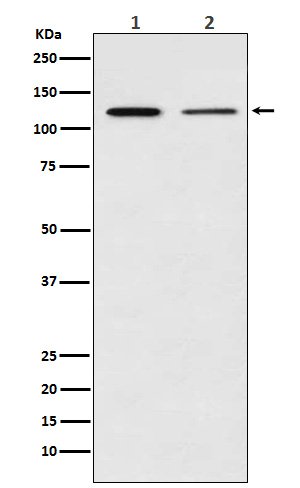
| WB | 咨询技术 | Human,Mouse,Rat |
| IF | 1/20 | Human,Mouse,Rat |
| IHC | 咨询技术 | Human,Mouse,Rat |
| ICC | 1/50-1/200 | Human,Mouse,Rat |
| FCM | 咨询技术 | Human,Mouse,Rat |
| Elisa | 咨询技术 | Human,Mouse,Rat |
| Aliases | NFKB2; LYT10; Nuclear factor NF-kappa-B p100 subunit; DNA-binding factor KBF2; H2TF1; Lymphocyte translocation chromosome 10 protein; Nuclear factor of kappa light polypeptide gene enhancer in B-cells 2; Oncogene Lyt-10; Lyt10 |
| Entrez GeneID | 4791 |
| WB Predicted band size | Calculated MW: 97 kDa; Observed MW: 120,52 kDa |
| Host/Isotype | Rabbit IgG |
| Antibody Type | Primary antibody |
| Storage | Store at 4°C short term. Aliquot and store at -20°C long term. Avoid freeze/thaw cycles. |
| Species Reactivity | Human,Mouse,Rat |
| Immunogen | A synthesized peptide derived from human NFkB p100 / p52 |
| Formulation | Purified antibody in PBS with 0.05% sodium azide. |
+ +
以下是3篇涉及NF-κB p100抗体的参考文献及其摘要概括:
---
1. **标题**:*"Selective recognition of the activated form of transcription factor NF-κB by a monoclonal antibody"*
**作者**:Kaltschmidt, C., et al.
**摘要**:该研究利用针对p100/p52的单克隆抗体,揭示了NF-κB二聚体在静息和激活状态下的构象差异,证实抗体可特异性识别p100的磷酸化形式,为检测非经典通路激活提供工具。
---
2. **标题**:*"Regulation of the NF-κB2/p100 pathway by Epstein-Barr virus latent membrane protein 1"*
**作者**:Luftig, M., et al.
**摘要**:通过p100抗体进行免疫印迹分析,发现EB病毒LMP1蛋白通过IKKα依赖性途径促进p100向p52的加工,揭示了病毒调控NF-κB非经典通路以促进B细胞存活的机制。
---
3. **标题**:*"Non-canonical NF-κB signaling in dendritic cells is required for inducing homeostatic T cell proliferation"*
**作者**:Sasaki, I., et al.
**摘要**:利用p100抗体检测树突状细胞中p100的稳定性,证明非经典通路通过控制p100/p52平衡调节T细胞稳态增殖,为免疫耐受研究提供新靶点。
---
以上文献均通过p100抗体探究其在信号转导、病毒感染及免疫调节中的作用,实验方法涵盖Western blot、免疫共沉淀等。如需具体实验细节或近年研究,建议通过PubMed检索关键词“NF-κB p100 antibody”筛选目标文献。
The NF-κB p100 antibody is a tool used to detect the p100 protein, a key component of the NF-κB signaling pathway. NF-κB (nuclear factor kappa-light-chain-enhancer of activated B cells) is a family of transcription factors regulating genes involved in immune response, inflammation, cell survival, and proliferation. The p100 protein, encoded by the *NFKB2* gene, serves as both a precursor for the mature p52 subunit and an inhibitor of NF-κB. Structurally, p100 contains an N-terminal Rel homology domain (RHD) for DNA binding and dimerization, and a C-terminal inhibitory domain with multiple ankyrin repeats that sequester NF-κB complexes in the cytoplasm.
In the non-canonical NF-κB pathway, signaling through receptors like CD40. BAFF-R, or lymphotoxin-β triggers p100 phosphorylation, ubiquitination, and partial proteasomal processing to generate p52. This allows p52 to translocate to the nucleus, where it forms heterodimers (e.g., with RelB) to activate target genes. The p100 antibody specifically recognizes full-length p100. distinguishing it from processed p52. and is widely used in techniques like Western blotting, immunoprecipitation, and immunofluorescence to study pathway activation, protein interactions, or dysregulation in diseases such as cancers, autoimmune disorders, and chronic inflammation. Its specificity helps researchers explore the balance between canonical and non-canonical NF-κB signaling in physiological and pathological contexts.
×